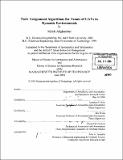| dc.contributor.advisor | Jonathan P. How and Eric Feron. | en_US |
| dc.contributor.author | Alighanbari, Mehdi, 1976- | en_US |
| dc.contributor.other | Massachusetts Institute of Technology. Operations Research Center. | en_US |
| dc.date.accessioned | 2005-06-02T18:31:04Z | |
| dc.date.available | 2005-06-02T18:31:04Z | |
| dc.date.copyright | 2004 | en_US |
| dc.date.issued | 2004 | en_US |
| dc.identifier.uri | http://hdl.handle.net/1721.1/17754 | |
| dc.description | Thesis (S.M.)--Massachusetts Institute of Technology, Dept. of Aeronautics and Astronautics; and, (S.M.)--Massachusetts Institute of Technology, Operations Research Center, 2004. | en_US |
| dc.description | Includes bibliographical references (p. 113-118). | en_US |
| dc.description.abstract | For many vehicles, obstacles, and targets, coordination of a fleet of Unmanned Aerial Vehicles (UAVs) is a very complicated optimization problem, and the computation time typically increases very rapidly with the problem size. Previous research proposed an approach to decompose this large problem into task assignment and trajectory problems, while capturing key features of the coupling between them. This enabled the control architecture to solve an assignment problem first to determine a sequence of waypoints for each vehicle to visit, and then concentrate on designing paths to visit these pre-assigned waypoints. Although this approach greatly simplifies the problem, the task assignment optimization was still too slow for real-time UAV operations. This thesis presents a new approach to the task assignment problem that is much better suited for replanning in a dynamic battlefield. The approach, called the Receding Horizon Task Assignment (RHTA) algorithm, is shown to achieve near-optimal performance with computational times that are feasible for real-time implementation. Further, this thesis extends the RHTA algorithm to account for the risk, noise, and uncertainty typically associated with the UAV environment. This work also provides new insights on the distinction between UAV coordination and cooperation. The benefits of these improvements to the UAV task assignment algorithms are demonstrated in several simulations and on two hardware platforms. | en_US |
| dc.description.statementofresponsibility | by Mehdi Alighanbari. | en_US |
| dc.format.extent | 118 p. | en_US |
| dc.format.extent | 6103649 bytes | |
| dc.format.extent | 6115872 bytes | |
| dc.format.mimetype | application/pdf | |
| dc.format.mimetype | application/pdf | |
| dc.language.iso | eng | en_US |
| dc.publisher | Massachusetts Institute of Technology | en_US |
| dc.rights | M.I.T. theses are protected by copyright. They may be viewed from this source for any purpose, but reproduction or distribution in any format is prohibited without written permission. See provided URL for inquiries about permission. | en_US |
| dc.rights.uri | http://dspace.mit.edu/handle/1721.1/7582 | |
| dc.subject | Aeronautics and Astronautics. | en_US |
| dc.subject | Operations Research Center. | en_US |
| dc.title | Task assignment algorithms for teams of UAVs in dynamic environments | en_US |
| dc.type | Thesis | en_US |
| dc.description.degree | S.M. | en_US |
| dc.contributor.department | Massachusetts Institute of Technology. Department of Aeronautics and Astronautics | |
| dc.contributor.department | Massachusetts Institute of Technology. Operations Research Center | |
| dc.identifier.oclc | 56523914 | en_US |
